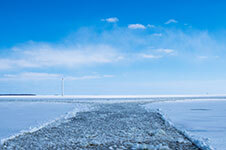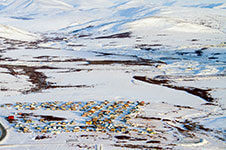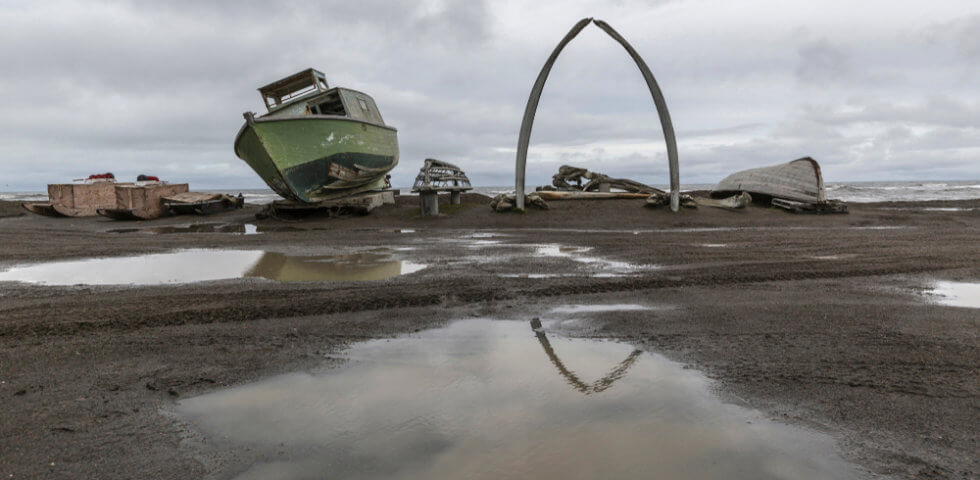The Arctic is not the same landscape today that it was decades, even years, ago. The effect climate change has had on the Arctic is a dire one, causing it to warm almost twice as quickly as the global average. Ice reduction is occurring at a rapid rate, with areas larger than the countries of Sweden, Denmark, and Norway combined melting away. It is because of this ever-evolving environment that Quintillion has built its subsea and terrestrial fiber optic cable network.
While much of the world has been deeply explored by humans, the transformation of the Arctic unveils a new frontier that is yet to be fully discovered. These changes have affected the communities that live near the Arctic, but they also present new opportunities, as well as the potential for confrontation and unknown risks. Communication has historically been a major issue for rural Alaskan communities, but Quintillion’s innovative fiber optic cable system has demonstrated that it is now possible to construct and install infrastructure that allows these communities to connect with the rest of the world.
How the Changing Arctic Affects Alaskan Communities
There is no question that climate change has shaped the Arctic and is creating new challenges for the rural Alaskan communities that Quintillion serves. Among one of the top concerns is an increase in flooding and erosion, which can be both dangerous to people living in rural Alaska, as well as cause damage to current infrastructure, such as buildings and roads. As land glaciers melt and run into the ocean, sea level rises. Changes to the water flow and ice structures surrounding Alaskan rivers are threatening communities, including villages near the Kuskokwim River where a melting ice jam could force hundreds of Alaskans to have to relocate.
Additionally, Alaskan communities that depend on hunting and fishing as a main source of food and income are struggling to adjust to changes in wildlife. Changing water temperatures have pushed fish, whales, and other marine life further from shore, forcing people to trek farther to harvest fish they rely on for economical and human sustenance. Climate changes have also made it more difficult for grazing animals, such as caribou and reindeer, to find food. This also presents the opportunity for new predators to move into the warming Arctic.
Alaska’s Economy and the Arctic: An Opportunity for Growth
While the environmental impact of global warming has provided many challenges for rural Alaskan communities, the unveiling of a new frontier has created opportunities for these same communities to grow economically. Less hostile weather conditions and newly exposed land has increased the amount of human activity in the Arctic. A wealth of national resources has paved the way for growth in the oil, gas, and mining industries, thus providing job opportunities. Moreover, a rise in commercial shipping and tourism can bring more money into Alaskan coastal and interior communities.
Quintillion’s Fiber Optic Cable Network: Increasing Connectivity
In today’s digital world, advancements in telecommunication technology offer Alaskan communities the largest potential for economic growth. A strong internet connection is necessary for not only bringing Alaskans together with each other but the rest of the world as well. Whether it be advancing education, acquiring information, facilitating communication, driving commerce, or accessing services (emergency, business, or otherwise), fast, reliable internet is crucial.
The need for affordable and accessible broadband service in rural Alaska became more apparent as the COVID-19 pandemic shutdowns made people rely on the internet even more than before. Virtual schooling, working remotely, and online ordering and shopping are only possible with reliable broadband service; unfortunately, Arctic conditions create a significant and unique logistical challenge for bringing affordable internet options to rural Alaskan communities.
With that being said, the most affordable, effective way to bring broadband services to rural Alaskan communities is fiber optic, and the changes taking place in the Arctic have made it possible for Quintillion to build its fiber optic cable network, which has connected an estimated 10,000 residents of rural communities to the digital world for the first time. It is a three-pair system with a capacity of 30 terabytes per second, which is scalable up to 90 terabytes per second. This network allows Alaskan internet providers, such as Alaska Communications, GCI, ASTAC, DRS Leonardo, and TelAlaska, to provide broadband services directly to the public, while also providing the broadband capacity to roll out LTE and 5 G wireless services, previously not a reality in this region.
Why the Alaska Arctic Is a Strategic Location
With the Arctic revealing many natural resources and opening new sea routes, America has found itself in the middle of competition with other world powers, specifically Russia and China. Melting ice regions provide gaps in national security that American adversaries can take advantage of, and our warning system is outdated. Additionally, many countries are rushing to the Arctic to have a part in extracting oils, gas, and the many other natural resources now becoming available and economically feasible.
As tensions rise in the Arctic, many compare the situation to the geopolitical climate of the 1950s, labeling it the “New Cold War.” Several countries have invested more time and resources into advancing their Arctic military exercises, including the United States. However, communication and all domain awareness is a major issue for our national defense system. As said by General Jacoby, Quintillion’s Senior Strategic Advisor, “If you can’t communicate, you cannot defend, you cannot compete.”
As America seeks to better compete with its adversaries and ramp up its national defense and security measures, better communication infrastructure is necessary to support an effective system. The current Distant Early Warning Line systems and the North Warning System are old and obsolete, operating at an incredibly slow speed of two megabits per second and lacking the ability to “see over the horizon”, creating major gaps in the US and North American Arctic defense, operational awareness and communications systems and capabilities. The Quintillion fiber optic cable network can enable the US federal government to proactively address these known gaps and support the development and implementation of a modernization and upgrade of reliable communications and ground-based systems necessary for adequately protecting the homeland in the decades ahead.
Quintillion in the Arctic: An Opportunity-Based Approach
While the shifting landscape of the Arctic has brought about many new genuine concerns for the environment, Alaskan communities, and national security, it has also created great opportunities to do good. Quintillion has positioned itself in the middle of all that is happening in the Arctic to help dramatically improve communication and overall capabilities. As the Arctic continues to transform, Quintillion plays a vital role in furthering communication, infrastructure, presence, and domain awareness for Alaska and the nation as a whole.
The current total network span is 1700 miles, with a 1200-mile subsea fiber optic cable network from Nome to Prudhoe Bay and a 500-mile terrestrial network from Prudhoe to Fairbanks. In the future, we plan to continue expanding this network, through partnerships and new potential funding sources, bringing reliable broadband further “in” to unserved or poorly served portions of Alaska and also “out,” extending the system to both Asia and Europe. With a new Asian Network and European Network in place, we can continue supporting national security and defense initiatives, while creating a more resilient and robust Alaskan telecommunication gateway.
Quintillion has also recently installed a new High Latitude Data Acquisition (HiLDA) Ground Station, in Utqiagvik, Alaska which is a new and unique aperture to the massive data sets in space, now and in the future, especially for low earth orbiting satellites that are typically in a polar orbit pattern. Ours is the highest latitude ground station in North America and the highest in the world located on US soil and US-owned and operated digital infrastructure. This ground station receives data downloads more than a dozen times in 24 hours from potentially hundreds of satellites, supporting Earth Observation technologies, tactical and strategic communications, and national security and defense missions.
Rather than have a crisis-focused approach, Quintillion chooses an opportunity-based approach in the US and North American Arctic. We seek to be proactive in providing digital infrastructure systems and capabilities to facilitate securing our nation and our allies, while simultaneously advancing the “art of the possible” for Alaskan communities struggling to thrive in the current and changing landscape. Communication and access to critical data are at the core of both of these issues, so we are acting now and urge others to join us in this adventure!
The Quintillion Network is connecting Alaska to the rest of the world. Contact us to learn more.















